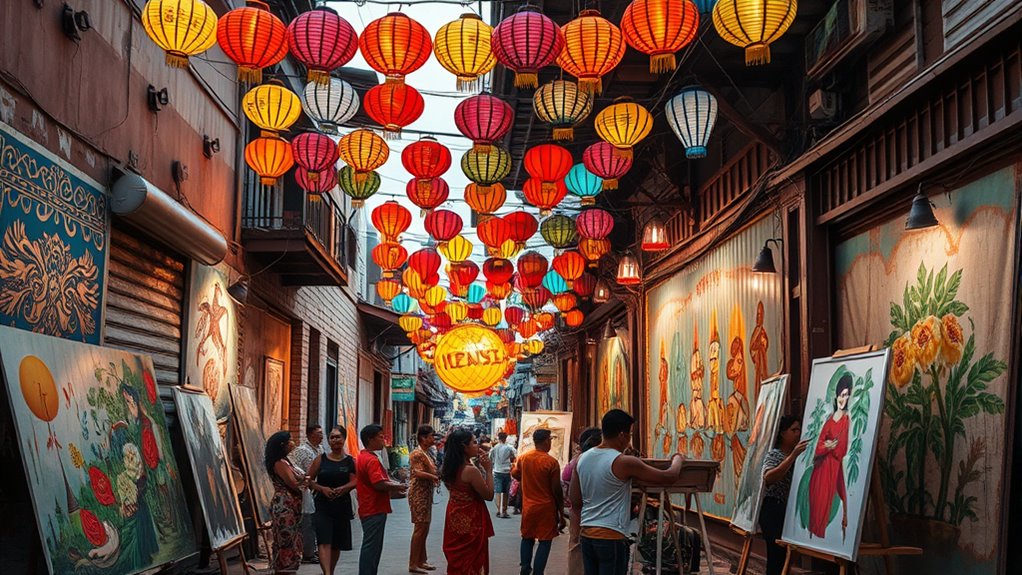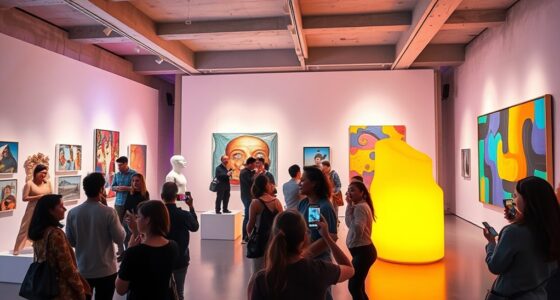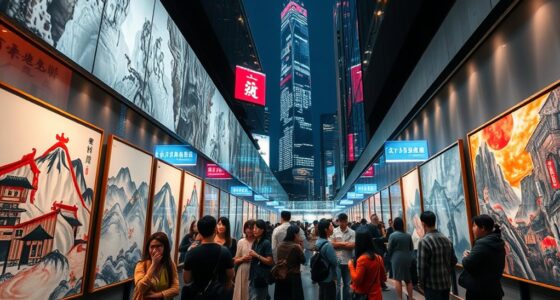Southeast Asia’s art scene is buzzing with innovation, blending traditional styles with contemporary ideas. Galleries, festivals, and initiatives showcase diverse media and themes like spirituality, history, and identity. Countries like Singapore, Vietnam, and Indonesia foster local talent and embrace new technologies like blockchain and digital platforms. Despite market challenges, the region’s artists are resilient, shaping a vibrant future. Explore how these dynamic movements and trends are putting Southeast Asia’s art on the world stage.
Key Takeaways
- Southeast Asian art integrates traditional motifs with contemporary themes, challenging linear narratives and emphasizing fragmented, culturally diverse stories.
- Regional initiatives like S.E.A. Focus highlight local artists, fostering cross-country collaboration and global visibility beyond mainstream markets.
- Emerging artists benefit from local galleries, museums, and digital platforms, strengthening regional cultural identity outside the global art radar.
- Technological advancements such as blockchain and online platforms enhance provenance, accessibility, and international engagement of Southeast Asian art.
- Sustainability and support for local talent are vital for nurturing resilient, innovative art scenes that transcend global market fluctuations.
Regional Artistic Movements Shaping the Scene

Regional artistic movements are actively shaping Southeast Asia’s vibrant art scene by fostering innovative dialogues between tradition and contemporary practices. Events like S.E.A. Focus 2025 explore themes such as “Disconnected Contemporaries,” challenging linear art histories and highlighting complex identities. You’ll see artists from eight countries blending heritage with modernity, questioning standard definitions of contemporary art. Curators emphasize fragmented narratives that reflect diverse histories and cultural realities. These movements promote cross-nation collaborations, connecting artists and galleries through shared exhibitions, ideas, and techniques. Such exchanges deepen regional connectivity and help Southeast Asian art engage with global conversations while maintaining local distinctiveness. By challenging Eurocentric frameworks, artists highlight the region’s hybrid influences, encouraging a nuanced understanding of Southeast Asia’s evolving artistic identities. Regional art initiatives are increasingly supporting emerging artists and fostering sustainable development within the local creative economies. Furthermore, the integration of local traditions with contemporary art practices enhances the region’s unique identity and broadens its international appeal. Incorporating regional artistic diversity enriches the dialogue and broadens the scope for innovation in contemporary art practices. Additionally, fostering cultural exchange programs can further strengthen regional unity and artistic growth. Promoting cultural intelligence among participating artists and institutions can also facilitate more effective cross-cultural collaborations and mutual understanding. Recognizing the importance of regional art ecosystems, many initiatives now focus on nurturing sustainable environments for artists to thrive.
Prominent Galleries and Major Art Events
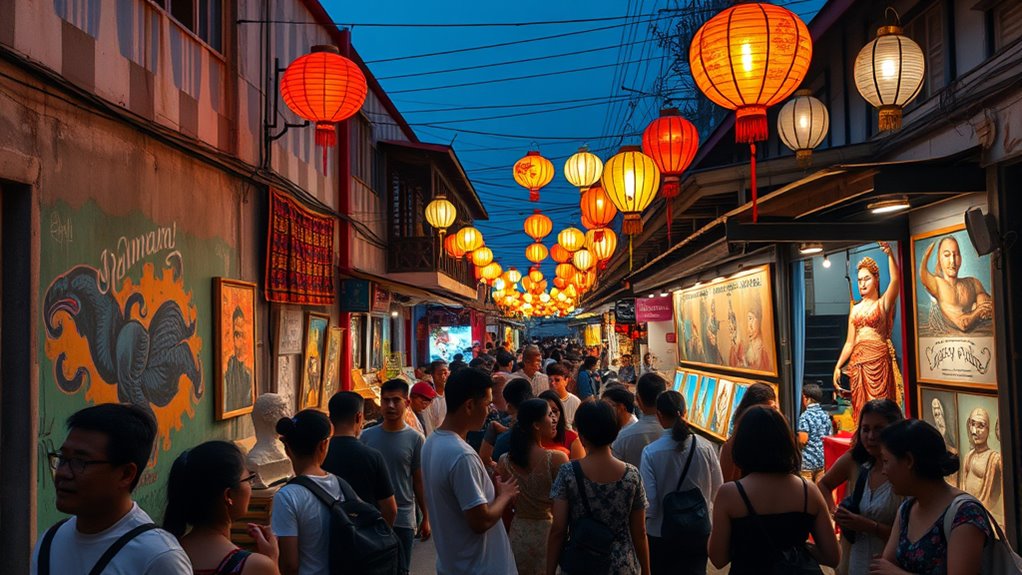
Southeast Asia boasts a dynamic network of galleries and major art events that play a crucial role in shaping its vibrant art scene. You can explore the National Gallery Singapore, home to over 8,000 works from the 19th century to today, highlighting regional cultural narratives. In Vietnam, the Fine Arts Museum in Ho Chi Minh City showcases the nation’s art evolution through colonial, communist, and modern periods. Bali’s Neka Art Museum emphasizes Balinese painting, while Singapore’s STPI advances contemporary Southeast Asian art through collaborations and residencies. Major regional events like ART SG, Art Jakarta, and Art Fair Philippines connect local artists with international audiences. Singapore’s S.E.A. Focus and Documenta 15 further elevate Southeast Asian art on the global stage. These events attract collectors, curators, and enthusiasts from around the world, fostering greater visibility and appreciation for the region’s diverse artistic practices. Additionally, the increasing integration of renewable energy in art installations and cultural projects highlights the region’s innovative approach to sustainability and creativity. The region’s commitment to cultural preservation complements its embrace of contemporary innovation, enriching its artistic landscape. Moreover, the adoption of digital exhibition technology enables more immersive and accessible viewing experiences across many exhibitions and festivals. The region’s focus on self-sufficiency in arts and crafts supports local economies and cultural resilience.
Distinct Styles and Influences Across Countries
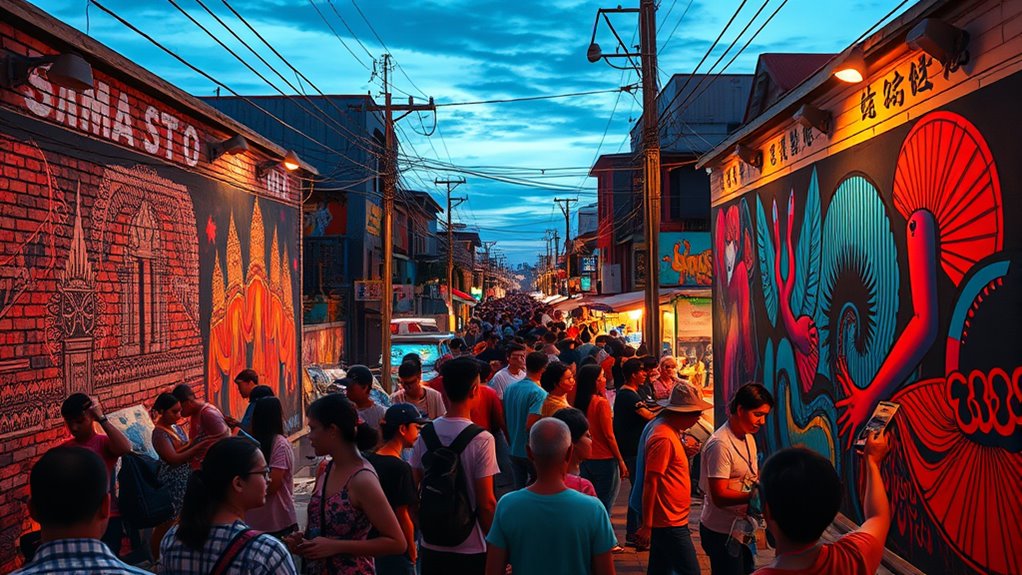
Across the diverse countries of Southeast Asia, distinctive artistic styles and influences reflect a rich tapestry of cultural interactions and local traditions. You’ll notice Indian influences in Cambodia and Thailand’s Buddhist and Hindu art, blending with indigenous forms like batik textiles and gamelan orchestras. Chinese elements shape Vietnamese, Laotian, and Cambodian art, showcasing a history of cultural exchange. Mythological themes often depict stories of gods, spirits, and humans, illustrating spiritual connections. Here’s a quick overview:
| Country | Key Art Style | Influences |
|---|---|---|
| Cambodia | Stone carvings, temple murals | Indian, indigenous animism |
| Thailand | Buddha images, wood carvings | Indian, local traditions |
| Indonesia | Batik textiles, wayang puppets | Indigenous, Indian |
| Vietnam | Lacquerware, ceramics | Chinese, local culture |
| Malaysia | Malay, Bornean styles | Indigenous, Indian |
Southeast Asian art also demonstrates a strong connection to nature and spirituality, often integrating symbols of harmony and cosmic balance into their designs. Many artworks incorporate spiritual symbolism, reflecting the region’s deep-rooted spiritual beliefs and practices. Additionally, the region’s art frequently employs sacred motifs that embody religious and mythological narratives, reinforcing their cultural significance.
Central Themes Driving Contemporary Art
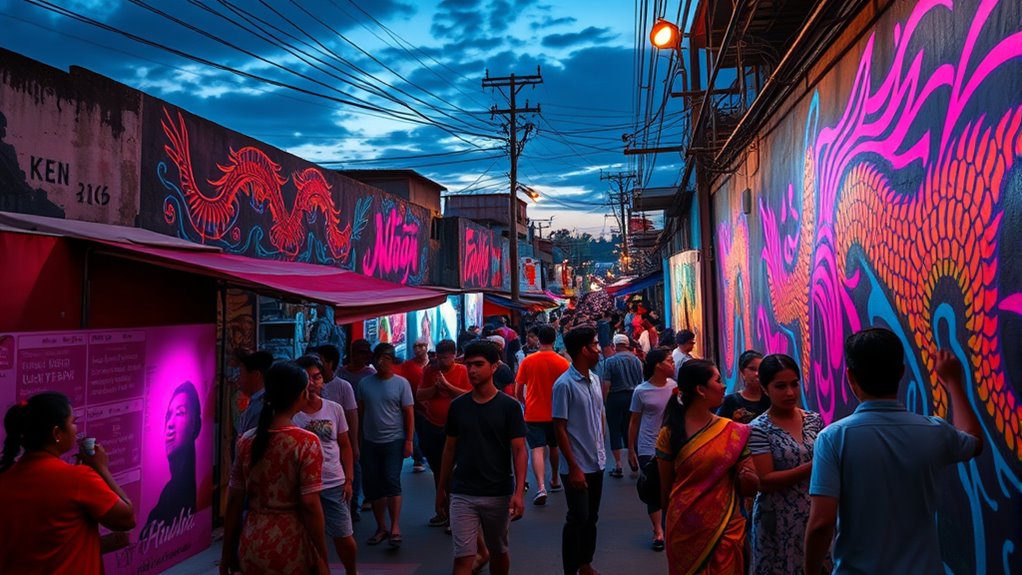
The vibrant tapestry of traditional styles and influences provides a strong foundation for contemporary art in Southeast Asia, where artists increasingly explore themes shaped by modern societal shifts. You’ll see tensions between globalization and local traditions, like Singapore’s manyang style blending Chinese and Western techniques. Despite global influences, artists stay deeply connected to their cultural roots, addressing regional issues and identity. Themes of time and change often surface, reflecting decay or scars from history. Exhibitions like S.E.A. Focus 2025 blur modern and contemporary categories, challenging perceptions. You’ll notice a rich diversity of styles, media, and perspectives across generations. Artists draw from their histories, societal shifts, and local politics, using art as a medium to explore and express complex cultural narratives. Contemporary art practices increasingly incorporate innovative techniques and materials, further enriching the region’s artistic landscape.
Future Trends and Challenges for Southeast Asian Art

Despite vibrant artistic innovation, Southeast Asian art faces significant future challenges shaped by shifting economic conditions and market dynamics. The region’s art market declined 31% in 2024, dropping to $8.4 billion, and gallery participation at ART SG shrank from 114 to 106 in 2025, signaling market contraction. Competition from Art Basel Hong Kong, which hosts over double ART SG’s galleries, intensifies. Collectors are becoming more strategic, moving away from overheated markets. Meanwhile, digital transformation offers new opportunities through online sales, NFTs, and social media, but also presents access and literacy challenges. Regional showcases like S.E.A. Focus and government support foster visibility. Artistic innovation continues through hybrid practices and cross-border collaborations, shaping a resilient, evolving future. Regular engagement with art market trends and technological advancements can help regional artists and institutions adapt effectively, especially as digital transformation reshapes how art is bought and sold. Emphasizing sustainable practices is increasingly important for long-term resilience in the art ecosystem. Additionally, fostering local artistic talent is crucial for sustaining regional cultural identity in a competitive global landscape. Integrating relevant technological advancements, such as blockchain for provenance, can also enhance trust and transparency within the art market.
Frequently Asked Questions
How Do Southeast Asian Artists Incorporate Traditional Motifs Into Modern Art?
You see Southeast Asian artists incorporate traditional motifs into modern art by reinterpreting ancient patterns like batik, ancestral figures, and mythical animals, blending them with contemporary techniques. They experiment with materials, combining traditional crafts with digital tools and mixed media. Collaborating with local artisans, they preserve cultural identity while addressing modern themes, often engaging communities through murals and performances. This fusion keeps heritage alive and makes their art uniquely relevant today.
What Role Do Local Communities Play in Regional Art Projects?
Think of local communities as the heartbeat of regional art projects, much like the chorus in a song. You actively participate in planning festivals, creating public art, and preserving cultural traditions. Your involvement fosters a sense of ownership and pride, ensuring these projects reflect your heritage. By sharing stories, skills, and traditions, you help keep Southeast Asia’s vibrant culture alive, connecting past and present in meaningful, community-driven ways.
How Is Digital Technology Transforming Southeast Asian Art Practices?
Digital technology is transforming Southeast Asian art practices by expanding creative possibilities and increasing accessibility. You can now use AI tools to blend traditional motifs with futuristic styles, enhance and preserve cultural artworks, and streamline animation or video production. Platforms like NFTs and blockchain empower you to showcase, sell, and protect your work globally. This digital shift fosters innovation, preserves heritage, and opens new economic opportunities for artists across the region.
Which Emerging Artists Are Expected to Influence the Future of the Scene?
You should watch out for rising artists like LYKN and FLIRT from Indonesia, SHERRY from Thailand, Zae from the Philippines, and Ánh Sáng AZA from Vietnam. These artists are blending genres, embracing digital platforms, and connecting traditional with modern influences. Their innovative approaches and growing regional visibility suggest they’ll shape Southeast Asia’s art scene, inspiring new trends and expanding global appreciation for the diverse voices across the region.
How Do Political and Social Issues Shape Contemporary Southeast Asian Art?
You see that political and social issues deeply influence contemporary Southeast Asian art. Artists use their work to challenge corruption, oppression, and social inequalities, often employing provocative mediums like street art and performance. They reflect regional histories, ethnic identities, and environmental concerns, fostering dialogue and activism. By engaging with these issues, you notice how art becomes a powerful tool for social commentary, promoting awareness and civic harmony amid complex socio-political landscapes.
Conclusion
As you explore Southeast Asia’s vibrant art scenes, you’ll find a tapestry woven with bold colors and dynamic stories. Beyond the global radar, these movements pulse with passion and resilience, echoing the heartbeat of diverse cultures. Embrace the journey through their evolving styles and themes, and watch as the future unfolds like a sunrise—bright, promising, and full of untapped creative energy waiting for you to discover.

